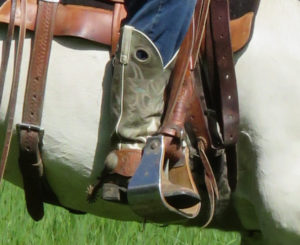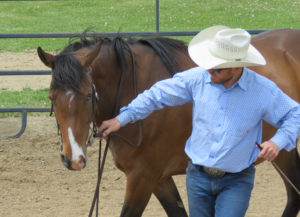We’ve been looking at different training styles in my last few posts, and today I’d like to discuss a style perhaps best described as “mechanical horsemanship.”
Mechanical horsemanship has many things in common with dictatorial horsemanship. However, practitioners of mechanical horsemanship have a distinguishing tendency to rely heavily on gear and gadgets when searching for solutions to training issues. For example, a horse that isn’t soft in the bridle
is likely to be put in a stronger bit, and a horse that tosses its head may get ridden in a tie-down or martingale. While almost any piece of gear can have benefits when used correctly and for the right reason, they are too often employed as a “quick fix” by the mechanical horseman. The problem with this
is that such fixes may succeed in masking the symptom (the head tossing, etc.), but will likely fail to address the core problem, which is most often a lack of connection and understanding between the horse and the human.
This same lack of connection also leads to another common feature of mechanical horsemanship: an emphasis on repetition. Because the focus of the mechanical horseman is on making the horse’s body do what we want, rather than on ensuring that the horse understands and feels comfortable with what
we are asking of them, horses trained with mechanical horsemanship often struggle to figure out how to respond to our requests. Practitioners of mechanical horsemanship often believe that the answer to the horse’s struggles lies in repeating exercises over and over again, which is thought to be necessary in order for horses to learn.
One upside to mechanical horsemanship is that its practitioners generally understand that getting emotional in response to what a horse does is not likely to be helpful. Their use of pressure is therefore rarely emotional, but it will often be heavy since they tend to rely on force to get their point across. You
will therefore see a lot of demanding and taking with the aids, which are thought of as a means to make things happen rather than as a conduit of communication.
Most horses do eventually learn what is wanted of them when trained with these methods, but there is a cost. Horses trained in a mechanical manner will often have a vacant, sour, or worried expression, and they tend to perform robotically, without joy or willingness. I believe this state is brought on by frustration and a lack of real relationship with their human handlers. Their needs are simply not being met, in large part because the trainers do not have a clear understanding of the way horses learn.
In my experience, horses can and do learn extremely quickly, with very few and sometimes no repetitions, if what you are asking of them is presented with clarity and fairness. Studies have shown that horses actually learn faster than dogs and that their memories are superb. This makes sense for a
prey animal like the horse, as they must learn very quickly in order to survive under natural circumstances. For example, if a horse is lucky enough to survive a cougar attack in a particular patch of brush, you can be certain he will avoid that patch of brush for the rest of his life – no need for multiple
repetitions!

Spurs are a great example of a type of gear that has great benefits when applied correctly, but if used as a “quick fix” to force a horse to move, they can cause real harm.

Horses learn very quickly in most cases if you present what you are asking with clarity and fairness.
Josh Nichol

Thanks Josh. Another fabulous article with very useful information. We are forever grateful.
I’m so glad you have found them helpful!
I love this! Thank you for sharing, I see this repetition a lot at the rodeo arena and can tell the horses are so bored with it, but just obeying. This approach of repetition does no lead to success in the arena.
You are welcome Cali!
I totally agree with your article. Trainers using mechanics because time is money for them. When owners use mechanical tools is because they don’t have the patience to teach the horse the movement. Especially young horses are trained to “get into a frame” before they even have their natural balance. In regards to the behavior that is shown by some horses, the cause should addressed, not the symptoms.
Teach the mind!
People seem to do things that have always been done or they see others doing without thinking it through. Thanks for shining a light on these issues!